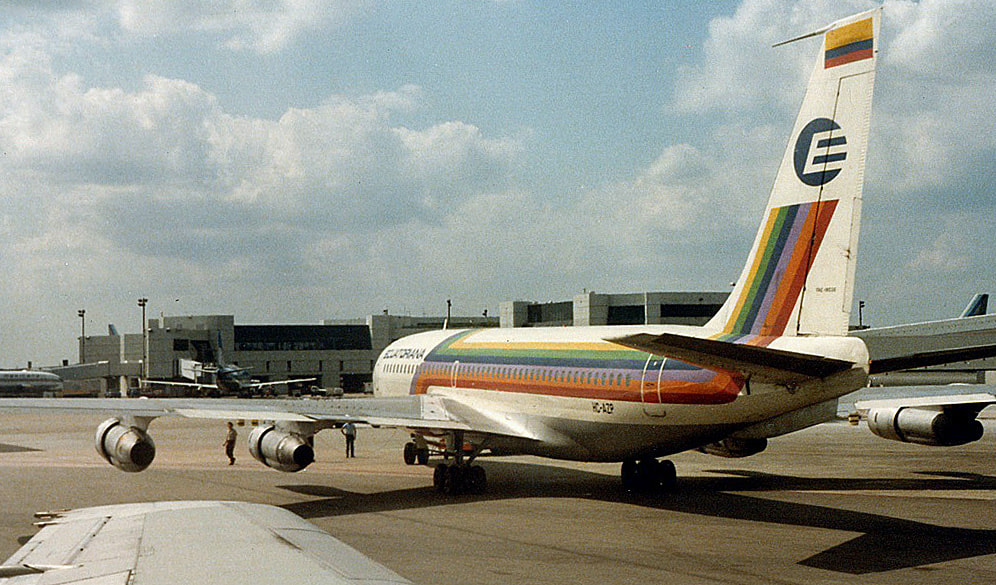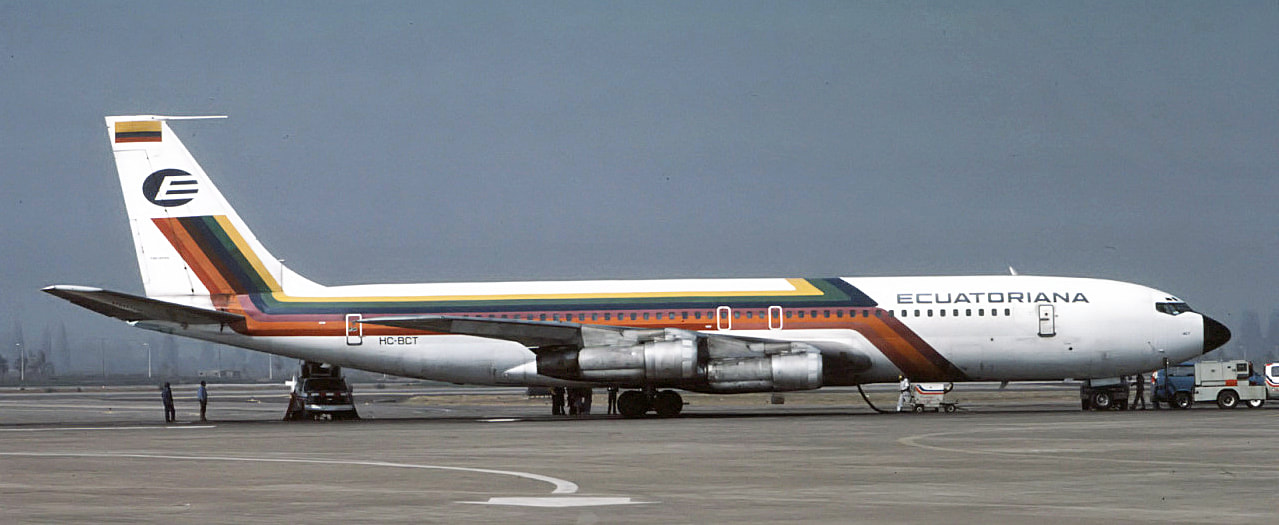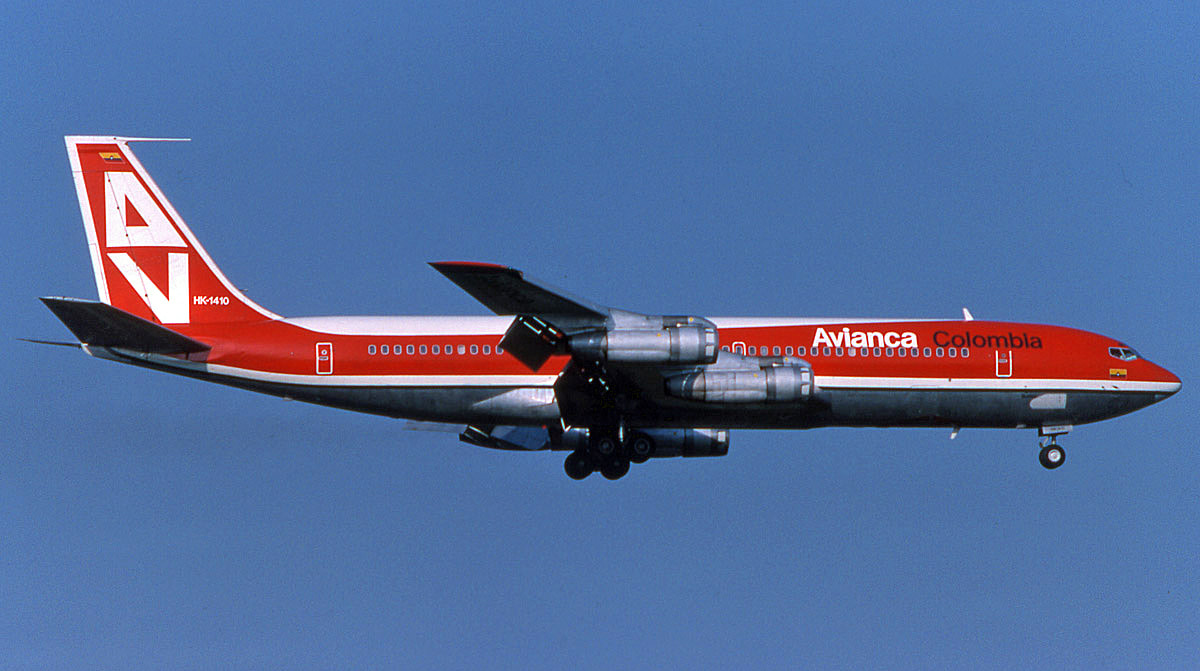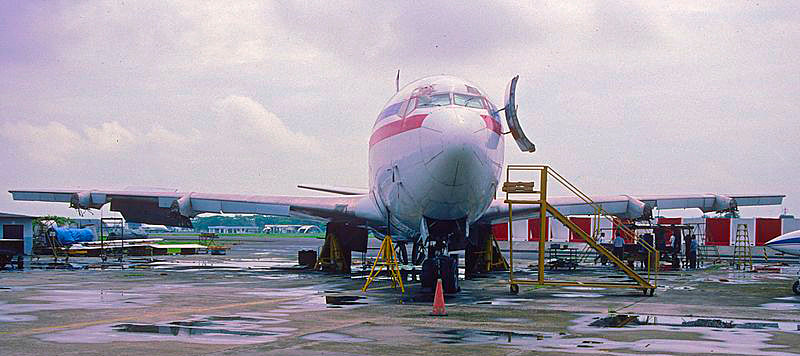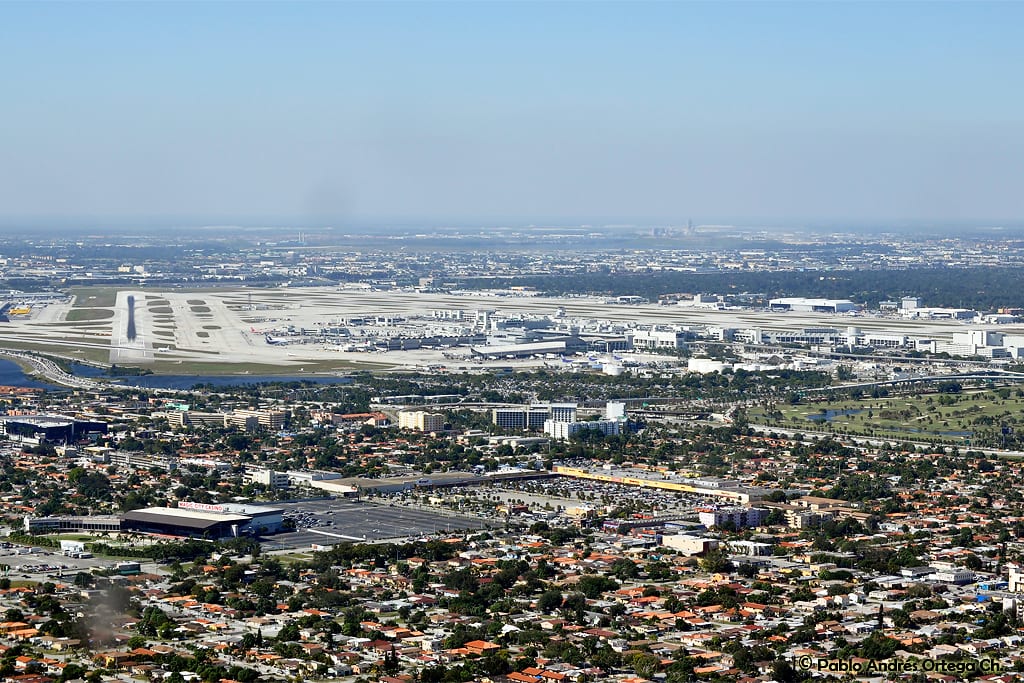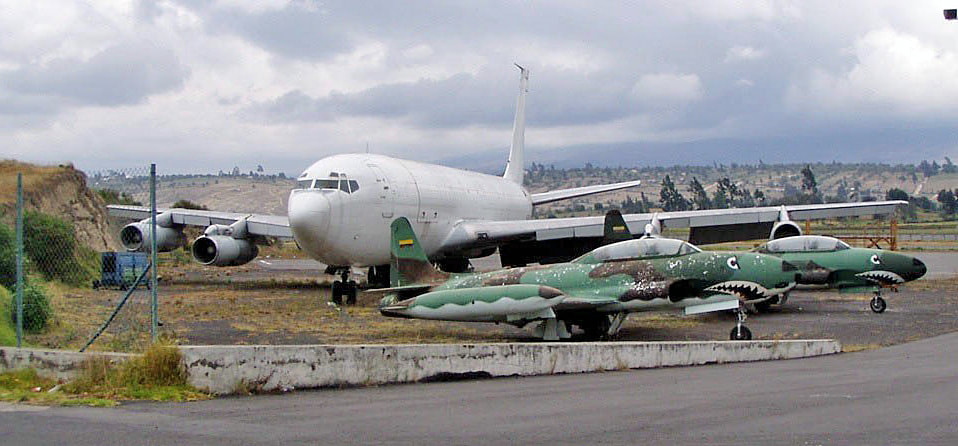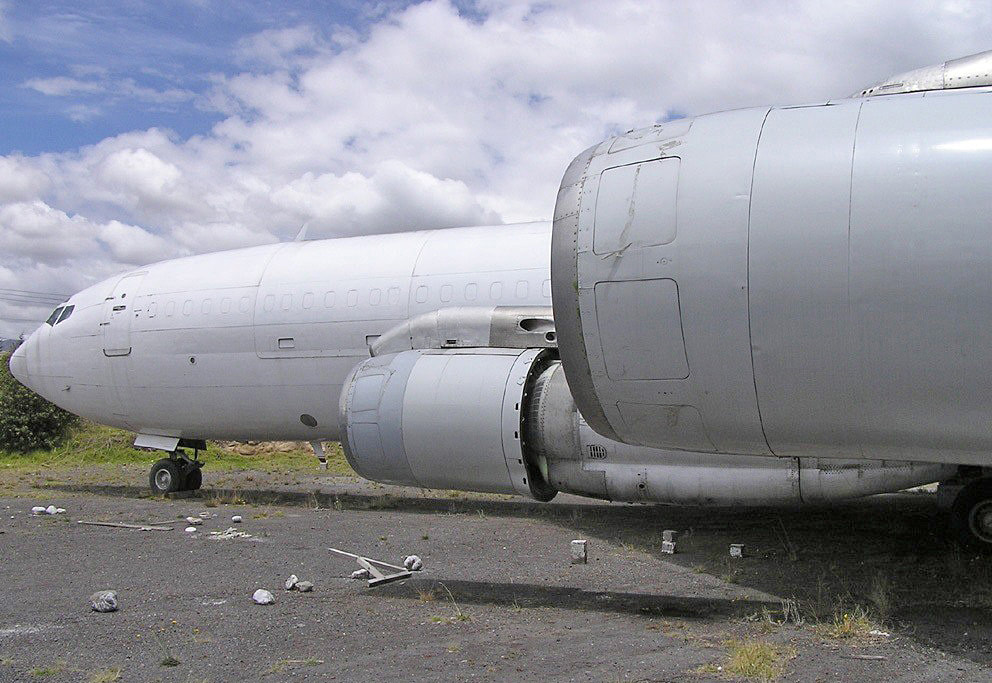My Last Boeing 707
By Capt. Fernando de la Torre Bekdach
Photo credit: Helio Bastos Salmón.
|
MY LAST BOEING 707
I started flying in 1979 on the B707'S. They were commercially retiring aircraft; let's say they were already obsolete. Te fuel consumption was excessive, maintenance expensive, engines very noisy and polluting, the interiors deteriorated, and other aircraft had arrived for intercontinental flights the B747, DC10, and L1011, the B727, B737 for short flights. The years that I flew them, we had excellent maintenance carried out by Israel Aircraft Industries (IAI) Company; in those years, there were situations for alternate procedures as in all aircraft. The airline had an impeccable record in its years of existence.
Like everything in life, everything comes to an end; in the middle of 1993, Ecuatorian Airlines, where I had worked for 14 ½ years, went bankrupt and closed after more than 35 years of operation. A fateful day that all pilots never want to arrive, but in such a changing world, bankruptcies, mergers, personnel reduction, or like the year 2020 with Covid-19, massive cancellation of crews eventually will arrive. It was incredibly frustrating to be out of work; it was the first time it had happened to me. I had excellent seniority with the company, and suddenly everything fell apart. The plans that the State had for the company were seen in advance. It was its disappearance; I was cautious of have saved some money for times of lean cows as they say vulgarly, mortgage, schooling of the children, payment of care fees, credit cards, and other items do not wait even if you are unemployed. When looking for a job in the few aviation companies that existed in the country, now, with the number of unemployed pilots looking for work, it was tough. Months passed, job applications were sent everywhere (there was no internet) nothing came out. The companies looked for younger people as copilots who have flown two crew aircraft; I was already walking for 40 years and had just flown a DC10, another outdated airplane. Suddenly I got a call to fly as a copilot in an unknown cargo company based at Miami International Airport. Without thinking twice, I accepted the job, I had not flown the B707 for three years, but a job is a job; I had to go to the simulator in a few days, read something about the 707 to remember procedures. One of the two airplanes that the company had, passed through Quito, I got on board, the captains was the owner of the company, I did not know him but his father, who was a pilot in the company that had just gone down the drain and had flown with him, also to his brother at school. Destination Miami (KMIA) via Manta (SEMT) and Barranquilla (SKBQ), night flight, the Captain and owner of the company told me to sit in the right seat so I could fly; I said to him that I had not flown 707 more than three years, he says it's like riding a bicycle, you don't forget, the avionics were entirely different, coming from the DC10 I was lost. We left for Barranquilla, no briefing, I didn't know how the weather was at the destination, two hours later we descended and lousy weather, non-precision approach, not to lengthen the story, we stayed high, as we passed the FAF (Final Approach Fix) we were not configured, we did not see the runway until we were over it, miss approach, climb, return to the VOR, do it again, I reread the approach chart, I was more than scared, on the second try we landed. Hours later, we were in Miami. The simulator and ground school was at the Pan Am Flight Academy. Four days later, I have rated again on the B707, a good feeling to return to flying and having a job. We returned to Quito; the wait was desperate since I didn't know when I would fly. The call arrived, I had to fly, the flight was going to last about five days, already with an experience I put a little more clothes in my suitcase, the flight was Quito (SEQU) -Miami (KMIA) with an overnight in Bogotá (SKBO). Summer 1994 the soccer world cup in the USA, that day Colombia-USA played, Bogotá was a deathly silence, everyone was watching the game, we had gone out to dinner in the area of the "Campin" the stadium of that city, returning to the hotel was an odyssey, there were no taxis, anyway, we got to watch the game in the room, Colombia was losing partially, suddenly a call from the Captain, we had to leave immediately for Miami, there was a problem, and if we didn't do it in 2 hours the authority would seize the plane, a "Van" was waiting outside the hotel, we arrived at the airport, the flight plan was already filed, everyone was upset by the situation, in no time we were in the air heading to Miami, at night or as the Mexicans say "Tecolote," upon arriving in Miami we found out that Colombia had lost to the US. It was eliminated; days later, they would assassinate one of its players. My new boss had done a business with the USAF to deliver an Avianca B707 that had been grounded for about 5 years in Bogotá for spare parts, we returned to see the airplane by airline, a few days to check the aircraft and get it ready for the ferry flight , flight plan Bogotá (SKBO) Miami (KMIA), sitting in the cockpit when requesting clearance from ATC, they inform us that the plane does not have permission, insurance, or anything, on board the plane there were two officers from the USAF coordinating the transfer and that everything is satisfactory, the Captain leaves furious to speak with Avianca's personnel, after the conversations ATC gave us the clearance, the problem was that at the time of going, Avianca's original registration since it left the factory in Seattle more than 25 years ago expired, it was HK4110 and now the new registration N22055, we flew with the original Avianca's registration until Curaçao's FIR where we changed to N22055 and all the way to Miami, the USAF took charge and flew it to some base to take this old bird apart. It was incredible that the airplane, after so many years of use in the airline and being grounded in Bogotá, flew as if it was its first flight out of the factory; we climbed straight to FL410, an incredible plane, years later I would do the same from Quito; fly another 707 that was grounded for four years. Once in Miami, several flights were made, one of them to Quito. I took advantage of that flight by taking my family to Florida, and they stayed for the summer. A contract came out, and we flew to Brazil, Viracopos (SBGP) in Campinas, an airport for cargo operations near Sao Paulo; we arrived a couple of days after the championship that Brazil won ended, and when we arrived, everybody on the ramp was too excited telling us Brazil "tetra" they had won a World Cup for the fourth time. The operation was in Brazil, specifically between Viracopos (SBKP) and Manaus (SBMN), a free port to carry merchandise and cars that did not pay taxes. Later on, Brazilians will inform us that there were a couple of flights to Europe, Cologne (EDDK) in Germany to bring cattle; incredibly, the aircraft was transformed into a corral and barn. I had previously flown across the Atlantic several times as Flight Engineer in another 707'S; it was my first time as a copilot; the flight was prepared, as always at night, and it was going to be long, almost 10 hours of flying, we were reinforced with another pilot, flight without any incidents, first time for me in Germany, we stayed a couple of days, Colonia, Cologne or Koln. This lovely city overlooks the Rhine river and has an ancient Gothic cathedral that is black on the outside; a couple of days in this city eating sausages, pork knuckles, and drinking beer. Coming back was different; we couldn't fly directly because of the weight, and we had something like 70 cows and a bull of some special European breed. The flight was Cologne (EDDK), Gran Canaria (GCLP), Recife (SBRF), Curitiba (SBCT), where the cattle were staying, and the final leg to Viracopos (SBKP). The flight itself without problems, again at night, essential to know how to handle livestock in flight, I had experience from my previous airline when I was a Flight Engineer, what the animals need is a lot of ventilation, you had to put more air through the "bleeds," in the middle of the Atlantic the smell of their sweat was incredible, you could see and smell what came out through the ventilation ducts and signs of humidity all over the windshield, we all smelled like cattle. Second stop, Recife Brazil, it was early in the morning and we had to do paperwork with the authority and payments for the use of the airport, I was in charge of the paperwork, everything normal until the Brazilian Civil Aviation requested a copy of the Crew's licenses, I returned to the plane for the documents and oh surprise, the Captain and the other pilot had only a validation and the date was expired, the Flight Engineer was Panamanian, he did not have a license for that airplane that was registered HC from Ecuador, horror since they could stop the airplane, the cattle could die if they stayed on board, the problem of the Engineer is solved, mine had expired but no date, the pilots had original Ecuador licenses with no date, there was no other option but to risk, I return with those licenses to the authority's office, God is great, they passed without any problem, with the papers and fuel we continued to Curitiba to leave the cattle, a flight of about 3 hours, upon arrival there was a storm in the area, it was torrential, the problem is that we were at the maximum landing weight, it was a relatively short runway and it was flooded at the moment, everything was fine until we touched down, brakes were applied, the reverse was activated and the plane did not decelerate normally , we enter hydroplaning, the reversers were no longer effective, the end of the runway is coming fast, we heard some explosions, we thought that the tires were exploding since the brakes were at maximum, in reality were the engines that entered into a " compressor stall", the airplane as if it was going off the runway to the left side, the captain uses the " steering tiller "to keep us from getting out, I press the right rudder pedal to keep us on the runway, we would stop a meter from the end of the runway, we taxied to the platform, unloaded the cattle, loaded fuel and back to Campinas for a super BBQ in a typical steakhouse and beer, it was a great flight. The Captain and owner of the plane returned to the US. A Brazilian pilot came without a license for this registration. We made some flights, and when we returned one day from Manaus, other pilots were waiting for us to fly the aircraft to Miami, the company had gone bankrupt. They didn't pay the lease, and they were seizing the airplane from us. They were leaving in a couple of hours. I told myself and the other pilots, "my ass, the moment of takeoff will be on that airplane to Miami." Quickly to the hotel, get the suitcase, and voila, 12 hours later I'm in Miami, again unemployed, it was a great aviation adventure. Luckily my family is in Miami; a friend let me use his house and a car; I have to think about sending my family back to Ecuador; it would cost me a fortune. Fortunately, a very dear relative helped me and gave me three tickets to my wife and two children. I went to see my former employer, who left us dumped in Brazil without warning us of the bankruptcy and the plane's seizure, to collect the salary for the months I flew for him, we reached an agreement. I got my money; I decided to get my FAA ATP (Airline Transport Pilot) license, look for a school that was approved by the authority and didn't cheat me; in Miami, at that time, some schools took advantage of Latin Americans, especially and took all the money and the poor dreamer of becoming a pilot was left without nothing, they recommend me a Cuban who had a school and is reliable in Tamiami, south of the city, I started the course, sent my family to Ecuador, and I'm relaxed. It was summer in this part of the planet, temperature and humidity were very high, the car runs out of A/C, driving back and forth was a bummer. I have not flown twin-engine piston aircraft in years; the first hours of training were difficult, the instructors are good, and they prepared me to pass the written, oral and practical exams. The writing test is by appointment at a computer site. FAA sends a password and the exam to the examiner; I arrive early in the morning, two hours later after finishing the exam, they gave me the result, "PASS," one step less, the school gave me the last flight to send me to the examiner for the check ride. Appointment with the "ogre," who they said is the man who would check me from my ATP; everything was ready, a couple of days later was the check ride. The examiner arrived in a van, which was his office. He spoke very little, asked for the result of the written exam, and I had to pay him in advance $ 400 "Green Chips." Keep in mind; if I didn't pass the check ride, you lose the money. The oral first, questions of all aviation subjects, knowledge of the aircraft, weight, and balance is verified, the flight plan is already in the system, I have to make a couple of precision approaches, a holding pattern and a non-precision approach set the "Hood" and fly, Tamiami (KTMB) Opa Locka (KOPF) Tamiami (KTMB) is the flight plan, the airplane a twin-engine Piper Seneca II, two hours later I had my FAA ATP in my pocket. There was no celebration; nobody cared that I had obtained the best pilot's license on the planet. I had to go home; I spent almost all the money on the ATP. , the friend who let me use his house and the car was in Miami. He flew a DC8 freighter. The next day they would leave early for Quito, and he gave me a ride in the cabin. That afternoon I was with my family. It has been a summer full of action, emotions, and adventure. Everything went well, my wife and children picked me up at the airport, and I went home to rest. I left for five days; I returned after three months. A couple of months had passed, I received a notification from the Air Force (FAE). I had to go for my Air Force Reserve re-training. I had done it a few times in the past. I look for my uniform, I ironed it, and I was ready. On the day of the recruitment, I went to the Air Force base in Quito. They inform us that this year's training would be in Manta (SEMT); we were in a C-130 Hercules flying in no time. Upon arrival, I bumped into many former colleagues and friends; I took the room with one of them. At night while we are talking, he recommended that I call a former coworker who was the Director of Operations of a cargo company (editor: Vias Aereas Manabitas / VIAMA, based at Manta, Ecuador). They had the 707 that was from our original company. When I returned to Quito, I contacted the Captain, very cordially told me that he would see what he could do. After a few days, he called that I am lucky: one of the copilots resigned, they hired me. Good news; I had a job again. It is almost Christmas; they sent me to the simulator and, in a few days, I was on the flight line. Almost all the pilots are ex workmates; they welcome me, they are happy that I have a job. The cargo operation with which I'm already familiar was based in Guayaquil (SEGU). The pilots rented an apartment. I had to share the expenses, and I had to do "commuting" to take the flights. I started to fly this 707 (editor: HC-BGP). Still, it was not as it was years ago; it looked deteriorated, it showed that it lacked maintenance, the person who did maintenance didn't look very suitable. The manuals were obsolete and outdated. A good friend of mine told this to the Captain. He told us not to say anything and be calm, "having a job flying is already fortunate at this time." For my position, many pilots would give anything to be seated in the right seat of that 707. I started flying, all good, I got used to this new operation, the paycheck at the end of the month made me happy, although I knew things were not as they should. We commented among ourselves; everyone is happy flying, the economic part is stable. One of the problems I saw is that the "pallets" did not have locks; I wondered why; someone said they were stolen in Miami. A couple of months had passed since I started flying, they informed us that we had to make a particular flight with the hazardous material. I already did it before in another company, and it is kind of dangerous. We left on a regular flight to Miami. On arrival, they informed us that we had to fly to "X" airport in another country to load all that material; we arrived at night, they parked us in a remote area, the cargo load is in a hangar, and there were hundreds of boxes with ammunition, rockets, grenades and more war material something like 70,000 lbs. It would take a few hours to load; we had to Take Off before the sun rises. We went to rest at the hotel until they called us. We left for the plane, we were ready, personally, with my experience in cargo airplanes I saw that the load was wrongly positioned, I talked to the Captain about it who was a good friend, he answered me that it was not my job, that's what the Flight Engineer is for and the loadmaster. Where a captain orders, no one else does. I had to keep quiet; everything was ready. We taxied to the runway. It was dawn, and with the checklist completed, we started the takeoff. My role as copilot in the 707 was to maintain the yoke pressed forward while the Captain used the "steering tiller" up to 80 knots; the plane began to move slowly due to the weight before 80 knots I felt that the yoke was pulled back, the nose rose and in thousandths of a second before informing the Captain yelled and said that he lost control of the plane. Luckily he aborted the takeoff at that speed. There was no control of the rudder due to lack of airflow and no control of the nose gear due to the nose up situation; once the takeoff was aborted, we carried out a 180 on the runway and returned to the remote platform. Groundstaff were waiting for us to see what happened. We got off the airplane, opened the doors, and oh surprise, the rear pallets moved, the load went all over the place, and we lost the center of gravity. When checking the cause, the pallets were not locked; they were not secure. We were lucky that this happened at a low speed. Today I can tell the story. Twenty-four hours later, the flight resumed; it is loaded in another way using the lower holds, too; we flew to our destination, and all went well. It had been some time since I started flying in this cargo company, I liked the job, much more relaxed than flying in a passenger airline, the company was growing, it had replaced a 727 with a 707 which I had already flown in the company that went bankrupt last year, new contracts were being flown everywhere within the American continent and some charters to Europe. The bad thing was the lack of maintenance. The airplanes had many problems, and it is not due to age; in my opinion, management did not want to spend on improvements, for example, the disconnect button of the copilot's autopilot didn't work for months, the MEL (minimum equipment list) gave some time to be repaired, or we had to ground the airplane, something that didn't happen. The competition in the freighter world was enormous. There were many companies, Andes, Arca, Zuliana, Tampa, Fine Air, Florida West, Challenge Air Cargo, Arrow, Fast Air, Lan, Mas Air, Ladeco, Millon Air, among others, and almost all flew B707'S or DC8'S except for Challenge that flew a new B757. These airplanes could be seen on the north platform in Miami that faced 36th Street and others that looked like ghost planes painted white with an N registration hard to see. Eventually, almost all of these companies would disappear. The US had sanctioned some countries, including ours, with category two aircraft. We could not change aircraft, routes, and frequencies that affected the operation. With the two B707'S flying, the operation had grown, there were three promotions to captains. They had been copilots in the B707 and DC10 for sixteen years; their opportunity came, the three were from the same promotion in another company that went bankrupt. The flights of one plane were mainly from Miami, and the other flew contracts all over the continent, especially one with VW between Mexico and Brazil plus other charters. The flights to Miami were 24 hours straight, also too many night flights. The Amazon flights were long, and there was little traffic, communications were complicated, especially in Brazil. I was happy with the job. The only thing that makes me dought was the lack of maintenance on the aircraft. Many things happened, and we talked about it on of the flights. The company bought a couple of extra 707'S to have spare parts. The incredible thing was that there were not sufficient. If a generator, CSD, starter, among others, was damaged, there was no spare. When leaving Miami one early morning, the Captain asked for the starting engines checklist; I informed him that we could not. All my instruments were collapsed, maintenance was called, nobody knew what happened. They were told to check. Indeed the VG (vertical gyro) was missing. After a while, the spare part appeared like magic, nobody knew who took it out, and there was no record in the logbook. We had got used to these "little problems," the salary was good, and it was to be assumed that we were happy to have a job. Another flight, another cargo operation of 24 hours in a row, the return from Miami was in the early morning when they called us to inform us that the airplane is already loaded. We arrive at the ramp around 4 in the morning. There were four passengers, one of the daughters of the owner of the company with her husband and two employees, super nervous she sits in the cockpit in the observer's seat behind the Captain, she had in her handstamps of the virgin Mary, a mini rosary and I think a missal, I told her to be calm, I also had a stamp of the virgin Mary, I took it out of my flight bag, I showed to her. I told her that between both symbols, everything will be fine and to stay calm. Take Off runway 09R, typical climb, vectors to the airway to head south via the island of Cuba, the Caribbean, Panama, the Pacific Ocean to Esmeraldas Ecuador, and the descent Guayaquil (SEGU). We were super heavy, those P&W JT3B-3D engines were at full power, we climbed at less than 1000 feet per minute, the Captain todl me that he couldn't sleep at all, he was going to take a mini nap (we always did it in shifts for safety to be rested) we passed Cuba and we were not levelleved yet, suddenly a loud noise, BUMM, the throttle lever of engine 2 returned to the idle position violently, the aircraft veered sharply to the left with an excessive bank angle, the disconnect button for the autopilot (I had said it) was inoperative for months, the AP is disconnected with the alternate method, the airplane was controlled and leveled, the Captain who was napping reacted, the aircraft is already controlled, a super and fast action of the Flight Engineer cutting off the engine almost instantly helped a lot, seconds that seem like an eternity had passed, we saw that the reverse of engine two suddenly opened, the Captain took over after doing an analysis of the situation, the worst part of the emergency was the passenger sitting in the observer's seat, she lost her composure, paniced, screamed, grabed the Captain's shirt, the Flight Engineer took care of her comforts her but she remained in a bad psychological state. We were heavy; we requested a lower level, we were assigned level FL250 and heading to Miami where we had "maintenance." Everything was under control, engine two was already shut down, checklist, three engines to land, and we had to dump fuel to land at the maximum weight, in a short time we were in Miami. Maintenance took over after the report was made. We were a little worried and nervous on the ground since this opening of the reverse in flight is very strange and seldom happens, if it happens very rarely to the hotel to rest and wait for maintenance to call us when they would do the troubleshooting and repair the reverse. Five hours later, maintenance called, the airplane was ready, we arrived at the aircraft, the lady passenger was no longer on board, only her husband. Here we went again, take off runway 12 to the south with vectors, everything normal, we did the checklist, we climbed, suddenly at 15000 feet, BUMM the reverse opens again, another bank angle more than 30 degrees, the Captain controlled the situation, we contacted ATC to returned to Miami, in a few minutes on the ground, the annoyed Captain told them that it doesn't matter how long would it take but to find the problem, crew to the hotel, two days later they reported that the aircraft was ready, there was some obstruction in a pneumatic duct, we accepted the ship, but we had to do a test flight. First, we returned to the ramp for a one-hour local flight plan. They loaded the airplane, fuel, and finally the return flight without any incident. The captains asked management to improve maintenance; almost everyone has had a technical problem that was not normal. On another night flight to Miami, we arrived at sunrise at the immigration and customs ramp. After passing the filters, a couple of FAA inspectors approached us, a spot or "ramp check," they asked for the crew's documents and the airplane, licenses, medical certificate, registration, and certificate of airworthiness. Everyone to the aircraft, one of the inspector began to check it externally, noted what he believed was wrong, the other inspector asked for the information of the arrival flight, flight plans, approach charts, weight, and balance, so far everything was fine, he requested to see aircraft manuals and the Minimum Equipment List (MEL), Then the problem began. This airplane once belonged to Pan Am, a company that no longer exists, an Iranian company, and later went to Ecuatoriana de Aviación, that does not exist either, the manuals and the MEL were from Pan Am and outdated, the inspector didn't want to know more, he met with the other inspector, and in a few hours, they informed us that the ship was "grounded," it could fly until all maintenance items were fixed. The company had to make and have its own manuals. This would take some time; in any case, we were in the air with this airplane ten days later. As things were, we continue with our flying jobs, the salary and some benefits were good, but it was no longer a pleasure to fly. There was a lot of tension in each flight, and we didn't know what could happen next. We left Guayaquil (SEGU), we were practically going to go around half of South America in one day. The crew was reinforced, two captains, two copilots, and a Flight Engineer. We noticed that the heading comparator's red light was on doing the pre-flight, which meant that there was a disagreement between the two compasses; it was corrected by checking with the magnetic compass. The Omegas for navigation were not reliable anymore. They didn't give correct information. We had a Garmin 100 GPS with the database expired, it was the best for navigating, during the flight we corrected the compasses, all good, we arrived at Viracopos (SBKP ) Campinas Brazil after a stop in Asunción Paraguay (SGAS) we had a low-pressure main gear tire, we didn't have a spare tire on the airplane, after inquiries they reported that they could get one in 48 hours. It was early morning. They sent us to the hotel. At night they informed us that they got the tire, the plane would be ready quickly. Another night flight to cross the entire Amazon basin to Ecuador. It was like 6 hours flight in the Amazon. In reality, there were not too many radio aids, communications are wrong, and they were very long "legs," after three hours of flight, we switched crews, I left at takeoff, the other would land in Guayaquil, when we overflew a VOR we noticed that the compasses were not right, the needles on the RMI (Radio Magnetic Indicator) pointed to the other side. Still, there was no indication of failure in the comparator. When I woke up already on the descent, I heard that the pilots were excited since the course we should have was wrong. The pilots knew the area well, and with visual references, the descent and approach were made almost without a problem, we were lucky that we were in VMC conditions. Luckily we were at sea level. In this situation in mountains and instrumental conditions, I don't know what would have happened. October 22, 1996, we arrived in Quito from Miami, taxing inn for parking on the cargo ramp, a B707 from Millon Air, a United States cargo company was leaving, we made signals with the lights of the airplanes, a few hours later when I saw the news on TV, this B707 crashed when taking off from Manta (SEMT) fell in the middle of the city, many people died, reading the details of the accident it turns out that I knew the Captain, he had given me simulator sessions a few months ago, this impacted me a lot, as did to my wife and family. It no longer mattered how good the job was, the benefits, the salary, and other extras; I had to find another one. I called a good friend who was flying in a local airline. We met for coffee; I asked him to help me in his company. A few days later, another friend pilot communicates, he had made an appointment with the director of operations; I went for the interview, a month after another phone call, this time from the Technical Vice President, I had been accepted to fly as Copilot an A320 with half the salary I had. On December 17, 1996, was my last flight to Miami (KMIA) Guayaquil (SEGU) Quito (SEQU) on the B707. Note: After checking my logbook from those years, I verify that in addition to the anecdotes I have told, I have been in three engines shut down in flight, a total loss of hydraulic, a windshield rupture, a loss of the automatic pressurization system, among other things. Capt. Fernando de la Torre Bekdach (retired) |
Me as F/O at the helm of Ecuatoriana Airlines Boeing 707-321B HC-BHY in 1990.
Ecuatoriana Airlines Boeing 720B HC-AZP, seen here in the early 80's. I started my career as F/E in this airplane long, long time ago. Special schemes are everywhere nowadays but back in the '70s Ecuatoriana produced a fleet of special schemes which have never been rivalled! Faced with competing against a myriad of colourful Braniff jets plus their colourful Calder 'Colours of South America' DC-8 the national airline of Ecuador produced a series of amazing schemes to emblazon their fleet.
Photo credit: Capt. Fernando de la Torre Bekdach. Boeing 720-023B HC-AZP "Galapagos" smoking out of Bogota-El Dorado in the late '70s. Eventually the Ecuatoriana fleet comprised 5 aircraft all with special schemes to represent the regions.
Photo credit: Capt. Fernando de la Torre Bekdach. Ecuatoriana Boeing 720-023B HC-AZQ, shown landing at Miami International Airport, Florida, in April 1975.
Photo credit: Richard Vanderford. In the 1970s, most South American national airlines were operated by national air forces. Through the Defence Ministry, the Ecuadorian Air Force bought two refurbished Boeing 707s for the airline from Israeli Aircraft Industries in a deal worth US$4,700,000 (equivalent to $24,365,789 in 2019) million.
Photo credit: Rob Hemelrijk. Ecuatoriana Airlines Boeing 720B HC-BDP "Lettuce". Empresa Ecuatoriana de Aviación was established in July 1974 as a Ecuadorean state owned national carrier. In line with many South American airlines of the time Ecuatoriana was run by the Ecuadorean Air Force with the aircraft carrying dual civilian / military registrations. Ecuatoriana's aircraft were something special, as all were painted in special schemes. Some sources have said that they were designed by an Ecuadorian artist, Oswaldo Guayasamin, however it may be that they were inspired by his work.
Photo credit: Bob Garrard. Boeing 707-321B HC-BFC called "Pajaro Del Sol" with it's distinctive color scheme. Both of the 707-320s were also acquired from Pan Am and were relatively new machines. HC-BFC had been delivered new on July 23, 1967 as N424PA 'Clipper Golden West'. She served a short lease with Merpati Nusantra of Indonesia from November 1975 to January 1976 prior to going to Ecuatoriana on lease from ATASCO. She was retired in February 1992 when she was exported to Israel as 4X-ATF for Arkia, however it doesn't appear that she ever flew with them and was instead used as a source of spares.
The 'Pajaro Del Sol' scheme she wore with Ecuatoriana was probably the most attractive of the jungle jet schemes. Ecuatoriana dazzled the aviation world with its amazing special livery variations during the 1970s. Photo credit: Micheal Prophet. In May 1979 the five passenger 720s/707s, one of which was a Combi often used as a freighter, were joined by a full freighter configured 707 registered HC-BGP. This introduced a new stunning scheme, which, with some modifications, was to become the new standard colours of the airline. What really made the cargo 707's livery stand out wasn't just the rainbow striping but also the golden fuselage.
Photo credit: Peter Hoppe. As with all of Ecuatoriana's 707s this aircraft was also of Pan Am heritage having joined PA as N451PA 'Clipper Union' on May 31, 1967. Prior to her lease to Ecuatoriana she had been N451RN with Iran Air. Named 'Manabi' she operated an all cargo service from Quito to Miami, Panama City and New York JFK. As you can see the livery involved six colourful bands - yellow, green and dark blue at the top and magenta, orange and red at the bottom. Along with the airline's traditional E logo this aircraft also gained a new freight motif, which to me looks like a stylised hand moving a cargo container.
Photo credit: Bob Garrard. The next and last Boeing 707 arrived in February 1981 and wore a white variation of the cargo scheme. Not quite as outlandish as the previous schemes it was still nonetheless an outstanding scheme. The primary differences between this and the freight scheme was the less curvy sweep of the bands onto the tail, unslanted flag on the tail and of course the white (or light cream) background colouring. This 707, HC-BHY, was originally N896PA delivered to Pan Am in June 1969 as 'Clipper Norseman'. In later years even the golden cargo 707 would be repainted into this standard scheme.
From 1979 however the airline began to standardise its colours though it did it with style and plenty of colour. Despite the outward appearance of beauty, as with many other latin american national airlines there was something rotten at the core of the airline, which would threaten its very survival into the 1990s.
Boeing 720-023B HC-AZQ "Imbabura" departing MIA in the late '70s.
Photo credit: Koboldmaki. Yesterday airliners. Boeing 707-321C - HC-BCT "Guayas", long gone, chopped-Up!
Photographer: Unknown. Boeing 720-023B HC-AZP during the part out process at Marana Pinal Air Park, in March 1987.
Photo credit: Jon Protor (RIP). An aviation enthusiast who I always admired! Unfortunately corruption and poor management blighted the airline in the late 80s and early 90s. Its operations became increasingly unreliable, while it also suffered in the face of competition from its Ecuadorean competitor SAETA and US Airlines (American and Continental). A combination of these factors and economic problems in South American in general led to the airline ceasing operations altogether in 1993.
Photo above; This Former Ecuatoriana Airlines 707 seems to be HC-BCT, it was scrapped in Guayaquil. AECA Cargo bought her for parts, same as HC-BHY. Boeing 707-359B HK-1410 was ferried by Capt. Fernando on June 25, 1994 from Bogota to Miami. Here the 707 was handed over to Enterprise Air, a USAF NGO. Her registration became N22055. Strangly several data-bases mention the 707 scrapped at Bogota in August 1994! Who knows exactly what has happend?
Photo credit: zrhspotter. AECA AIRLINES Boeing 707-330C, HC-BTB, was photographed at Maimi International airport in April 1996, against a background of several more modern freighters. Capt. Fernando flew this 707 from 1995 untill including 1997.
Photo credit: Airwim. Boeing 707-330C, HC-BTB, departing for an early morning run, fully filled with fuel, for Miami, Florida.
Photo credit: Helio Bastos Salmón. The sad remains of a once sleek airliner, now awaiting scrapping with the engines already gone. Boeing 707-330C HC-BTB was stored at Latacunga since 2000.
Photo credit: Aero Icarus. The well-known Miami Approach.
Boeing 707-321C HC-BGP. The one time Pan Am "Clipper Union" sits outside the small commercial air terminal at Manta, just about to disgourge a full load of IBM personal computers.
Photo credit: Andy Martin. Boeing 707-321C HC-BGP. Long Gone, Chopped-Up!
Photo credit: Jens67. Time capsules of aviation history, Boeing 707-321C HC-BGP at Latacunga November 2004.
Photo credit: Stefano Roto. Boeing 707-321C HC-BGP ended its career in a salvage yard of Latacunga airport, Ecuador.
Photo credit: Stefano Roto. |
If you enjoyed this story and you want to publish your own aviation memoires, do not hesitate and contact me at [email protected].










